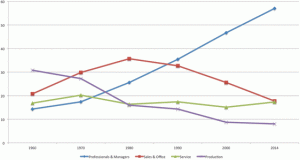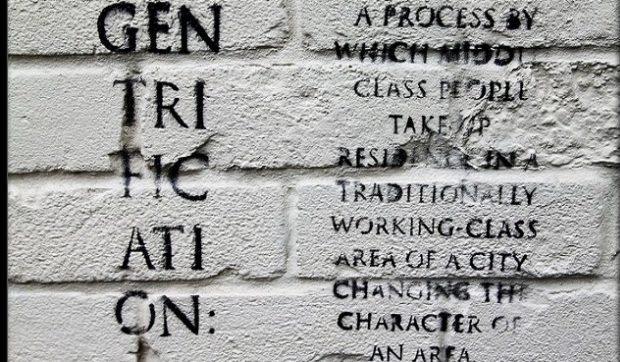The Effects of Gentrification on Neighborhood Public Schools by Micere Keels, Julia Burdick-Will, and Sara Keene
Micere Keels, Julia Burdick-Will, and Sara Keene in their article “The Effects of Gentrification on Neighborhood Public Schools looked at the effects of gentrification on school-level student math and reading achievements. They also looked at whether demographic changes in the student body brought forth from gentrification caused changes in academic achievement within Chicago Public Schools. Because little data is present for gentrification’s effects on public schools in urban areas, Keels, Burdick-Wills, and Keene wanted to find out whether gentrification bring positive impacts upon public schools like it does with many other public services.
The Chicago Public School system is composed of neighborhood assignment schools, nonability-based choice schools, and ability-based schools whose student bodies are largely segregated by income and race.1 Less than 10% of CPS students are white, and more than 90% are from low-income families.2 In order to attract more gentrifying families, Chicago passed a set of school choice policies under its “Renaissance 2010” initiative which added magnet schools and more school choice options into the district.3 This type of action tends to benefit white, middle-to-upper class families within the city that have resources and knowledge to navigate the system while leaving low-income, minority families with little to no say in their children’s education.
In theory, gentrification can be a mechanism of desegregating and de-stratifying urban public school systems; because both gentrifying and non-gentrifying families in communities have the opportunity to send their children to the same school, urban public schools could be a platform for families of different socioeconomic classes and races to build trust and relationships.4 Keels, Burdick-Wills, and Keene used third grade students’ annual standardized reading and math scores to measure changes in academic achievement from the 1992-1993 school year to the 2003-2004 school year.
The three found that gentrification actually has little effect on neighborhood public schools, with no aggregate academic benefit being found from middle-class influx.5 In their findings, Keels, Burdick-Wills, and Keene saw that individual students attending first grade in a gentrifying neighborhood school had no association with a growth rate in tests scores from 1992-2004.6 These findings seem logical because gentrifying parents have the resources to explore all educational options for their children both inside and outside of urban areas; therefore, because these families have the ability to enroll in schools outside of CPS, their influx may bring no change to CPS and leaves original students in the area with less agency and choice than before gentrification. As Keels, Burdick-Wills, and Keene also noted in their discussion that the externalities caused by neighborhood gentrification can even have negative effects on low-income, minority families due to the departure of resources into different school institutions and the decrease in school choice available to students.7 Thus, Keels, Burdick-Wills, and Keene found that gentrification has little or negative impact on school choice due to differences in privilege and resources inherent to families based on socioeconomic status and race.
African Americans, Gentrification, and Neoliberal Urbanization: The Case of Fort Greene, Brooklyn by Themis Chronopoulis
In “African Americans, Gentrification, and Neoliberal Urbanization: The Case of Fort Greene, Brooklyn,” Themis Chronopoulis examined the rapid gentrification of predominantly white professionals occurring in Fort Greene, NY. This project looked at the changes in demographics from 1960-2014 in the area. Until 2003, Chronopoulos found that the gentrification in Fort Greene was largely done by middle-class African Americans which had been found as a usual occurrence in many previous studies.8 However, in this New York City neighborhood, whites have been the gentrifying agents since 2003, largely because of its longevity as a middle-class neighborhood, its proximity to downtown Brooklyn, and its new commercial infrastructure 9
This image below from Chronopoulis’s article breaks down the influx of individuals into the Fort Greene area by demographic group. As you can see, white families have entered the area at an increasing rate since 2003 with its reputation as a “middle-class community.” This has coincided with a sharp decrease in the number of African Americans entering the neighborhood. Thus, the graphic highlights the change in autonomy and increasing presence of white individuals into a known “middle-class space,” causing a change in culture that had existed in the community for over 40 years.
 10
10
The next graphic highlights the change in job professions entering Fort Greene from 1960-2014. One can see the rise of professionals and managers entering the space from 1970 to 2014. This trend contrasts sharply with the gradual decline of both office and service professionals in the neighborhood. Thus, we see a socioeconomic shift within the community, contributing to an eventual culture change, too.
 11
11
Therefore, in his article, Chronopoulis depicts one of the first black urban neighborhoods in the United Space becoming more and more white after establishing itself as a Black, middle-class community.12 Through this case study, we are able to see the infiltration of white individuals into a space that is not their own and using their resources to slowly transform the culture from black to white.
Here are links to the actual articles for your own enjoyment!
The Effects of Gentrification on Neighborhood Public Schools
African Americans, Gentrification, and Neoliberal Urbanization: The Case of Fort Greene, Brooklyn
References:
1 Keels, M., Burdick‐Will, J., & Keene, S. (2013, September 13). The Effects of Gentrification on Neighborhood Public Schools. Retrieved May 1, 2017, from http://onlinelibrary.wiley.com/doi/10.1111/cico.12027/abstract
2 Ibid
3 Ibid
4 Ibid
5 Ibid
6 Ibid
7 Ibid
8 Chronopoulos, T. (2016). African Americans, Gentrification, and Neoliberal Urbanization: The Case of Fort Greene, Brooklyn. Journal of African American Studies, 20(3-4), 294-322. doi:10.1007/s12111-016-9332-6
9 Ibid
10 Ibid
11Ibid
12 Ibid
